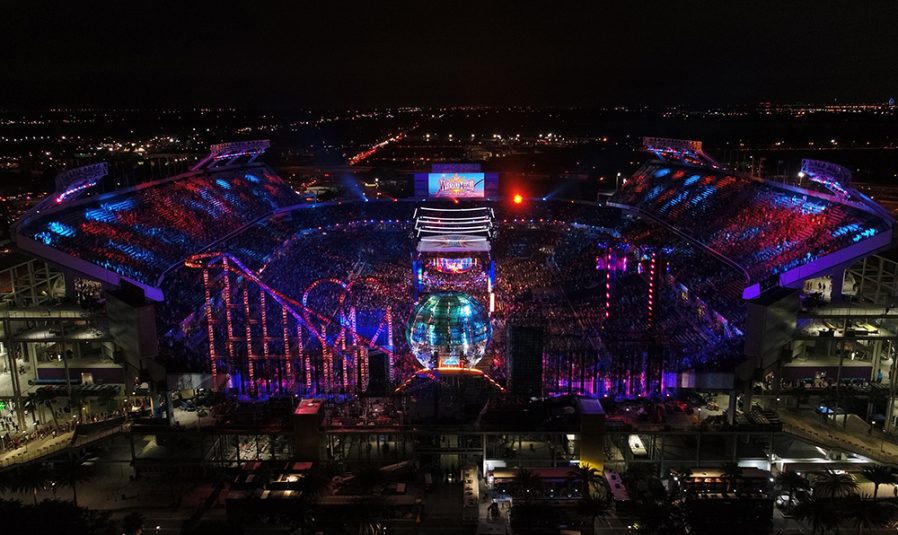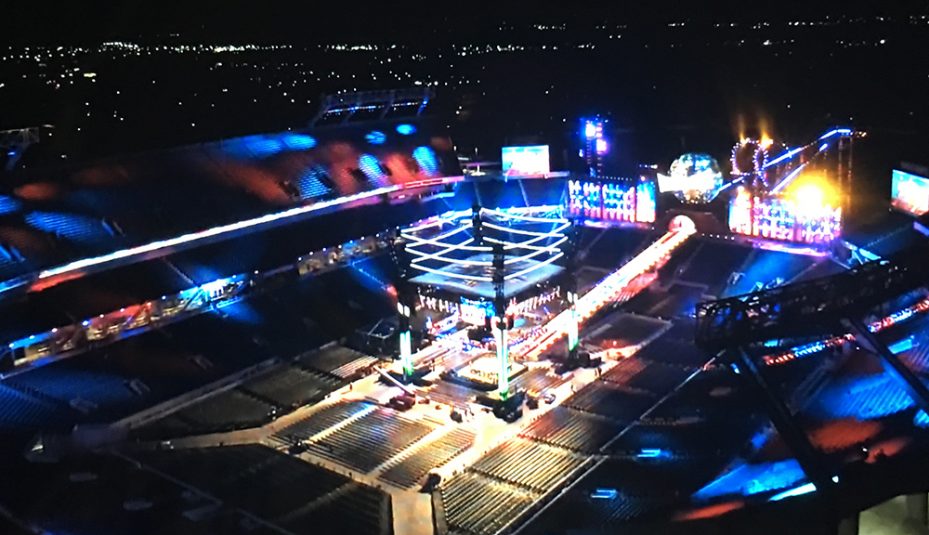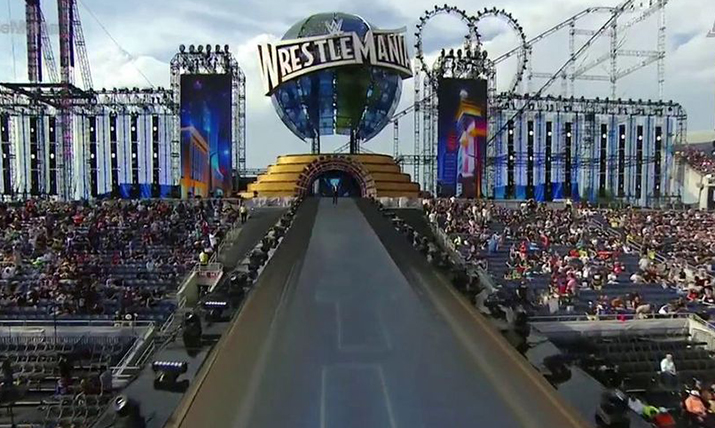WWE’s NEP Mobile Units, Drone Cam Debut at Record-Breaking WrestleMania
WrestleMania 33, the most-watched and highest-attended ever, also marked WWE’s largest production in the event’s history
Story Highlights
Just under a year ago, WWE launched a trio of state-of-the-art NEP mobile units designed specifically to scale up for one of the largest and most complex annual live productions in North America: WrestleMania. Last weekend in Orlando, that vision became reality when WWE leveraged the full power of the IP-based WWE 1, 2, and 3 trucks to deliver the most-watched and highest-attended WrestleMania in history.
“Utilizing the power of our new truck platforms was a game-changer for us,” says Duncan Leslie, SVP, event technical operations, WWE. “The ability to expand internally with [the IP router] really helped our engineering staff, from NEP: they didn’t have to max out the truck and drive themselves crazy [as in in years past]. We designed that truck for Mania, and it came through for us with flying colors.”
Of course, WrestleMania is about much more than just the main event, with a week chock-full of live event coverage and original content presented on both linear television and the WWE Network digital subscription service.
“WrestleMania’s significance to our company has been redefined now that we have our network, because it’s a driver in terms of building our subscriber base,” says Mike Grossman, SVP, television operations, WWE. “So we create an immense amount of great shoulder programming during the week to support the main event and to drive people to WrestleMania. This year, WrestleMania drove our network to almost 2 million subscribers, which is huge for our company.”
WWE Goes Full Bore With Powerful New Trucks
WWE 1, 2, and 3 handled not only the WrestleMania 33 production on Sunday but also coverage of all other WrestleMania Week events taking place at the Citrus Bowl. Meanwhile, NEP Red and Black — WWE’s former primary trucks, now refurbished — were at the Amway Center producing such events as NXT TakeOver, the WWE Hall of Fame ceremony, Monday Night Raw, and Smackdown Live.
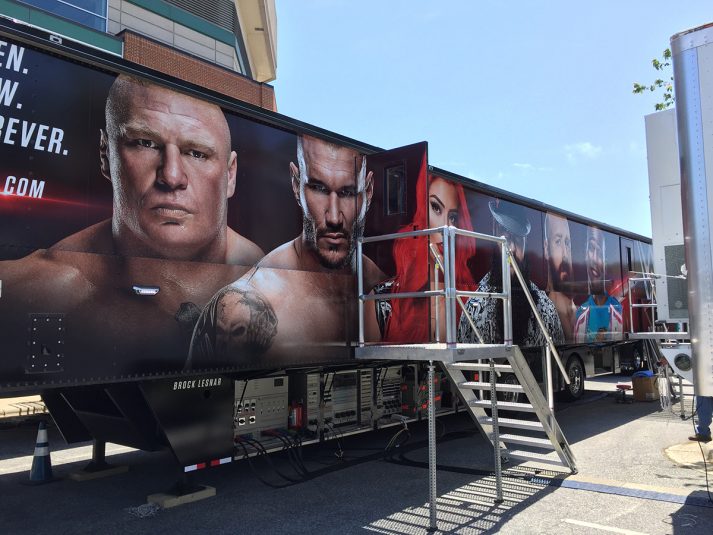
WWE’s NEP mobile units, which launched last year, feature a significantly larger footprint with two double expandos and a supporting C unit.
NEP 1, 2, and 3 are built around an Evertz EXE IP router, a Grass Valley Kayenne K-Frame switcher (192 inputs, 9M/E, two control panels), a 40-GBps fiber backbone, and Dante IP-based audio/comms. The trio also boasts a massive footprint, with two double expandos and a C unit housing two control rooms and four audio-mixing rooms. The trucks roll with three Sony HDC-4300 cameras operating at 240 fps (4X slo-mo) and a battalion of Sony HDC-2500’s (set to be upgraded to HDC-4300’s at some point this year), all outfitted with new Canon lenses.
“These trucks let us take our [WrestleMania] show to the [next level],” says Leslie. “We had room to expand the router and expand our Dante infrastructure, and, believe it or not, we still had a little headroom in the router at the end of the day. We utilized the power and scope of the IP system to manage the incredible amount of feeds that are required, including 200 monitors all with discrete [feeds]. We basically wanted to maximize our show as much as possible.”
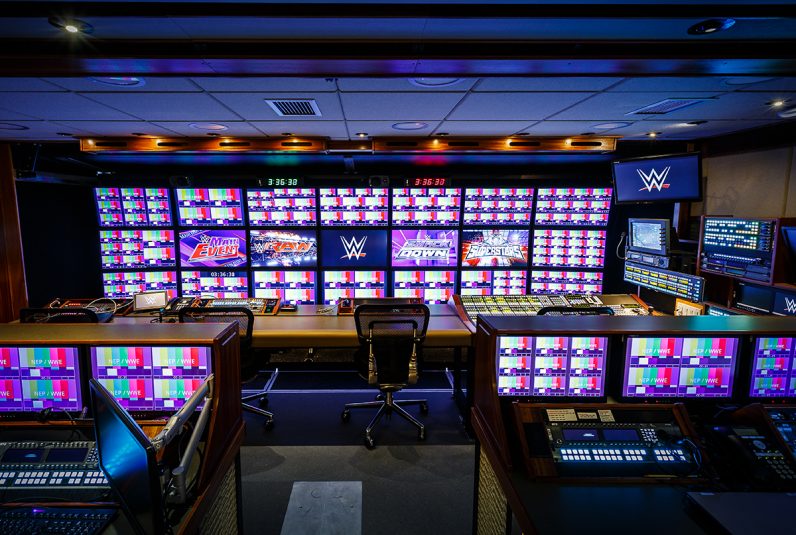
NEP and WWE worked to make the primary control room as ergonomically similar to the previous truck’s as possible.
And maximize they did. WWE’s 31-camera production transmitted 39 isolated video feeds and more than 500 channels or audio to the trucks, and all were ingested into a 40-TB RAID array. WWE ran 31 discrete transmission paths over a dedicated 1-GBps circuit (including 500 MBps from the truck and 250 MBps backstage from the stadium) between Orlando and its headquarters in Stamford, CT; a satellite uplink was used for exchange of long-form content. WWE relied heavily on Aspera for high-speed file transfer between the two locations.
In addition, announcers for eight languages were onsite to supply international feeds for the WWE Network.
WrestleMania Takes Flight With Drone Coverage
For the first time ever, WWE integrated a drone for its WrestleMania coverage. Supplied by Pneumatic Drone Cinema, the system provided live aerial shots of the action, and WWE pulled stills out of the 4K frame to be distributed across various digital platforms. Unlike with traditional aerial shots provided by helicopters (which were still on hand for the show), the drone allowed the WWE production team to capture more-intimate overhead views since it could get closer to the set, according to Leslie.
“The drone was very successful for us,” he notes. “Obviously, the FAA is very stringent about flying over the stadium with a drone during any event, especially Mania. But we did all the paperwork well ahead of time and took the necessary [precautions] so it was approved.
“[The drone team] would bring the drone down [and] run the card in, and then we would ingest it,” he continues. “One of the [structures] from the ground all the way up top was about 200 ft., so they had to send the drone up pretty high. Occasionally, we would have some transmission hits because of all the RF in the distance, but, once we found clear lanes, it worked out great.”
Driving WWE Network to New Heights
In addition to the events taking place in Orlando, WWE Network featured a full slate of original programming during WrestleMania Week (March 27 – April 2), including WWE 24: WrestleMania Monday; a special edition of WWE Talking Smack; Kurt Angle: Oh, It’s True…It’s True!, a WWE Network exclusive interview with 2017 WWE Hall of Fame inductee Kurt Angle; and a new episode of Bring It to the Table. On top of that, WWE’s Stamford production facility continued to churn out fresh content throughout the week and supported nine hours of shoulder programming leading up to WrestleMania on Sunday.
“Having our own network is such an amazing tool, not only to drive our sub base; it gives us a creative tool to build our product in a consumable and fan-friendly way,” says Grossman. “All that [live] shoulder programming requires a lot of content, including prepackaged material, graphics, music, and so on. We’re constantly feeding content to the field for all those shows. That is where Stamford is key in the process.”
All About the Spectacle at WrestleMania
Never one to shy away from spectacle, WWE worked with NEP Screenworks to erect the largest set in WrestleMania history, headlined by a 280-ft.-long ramp completely covered by two types of LED products. WWE and Screenworks were also tasked with engineering an elevator that would allow The Undertaker to emerge from the ramp, creating the evening’s most dramatic moment.
“We figured out a way to put a hole in the ramp for the elevator, but it was very complex,” Leslie explains. “Toward the end of the show, the Screenworks techs had to come out and take the [LED] tiles off, the elevator came up, and then they put the tiles back on. It was quite an engineering feat.”
NEP Screenworks and WWE drove in 13 semitrailers full of video equipment for the in-venue event, including the most LEDs ever. In all, WrestleMania required more than 100 semis at the stadium, including two filled solely with bolts.
